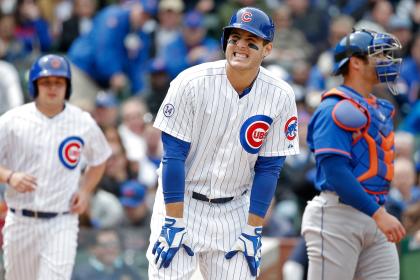Anthony Rizzo and the art of getting plunked
SAN DIEGO – Anthony Rizzo, a towering figure in a Chicago Cubs renaissance whose plate appearances have begun to resemble Butch Cassidy’s dash from that Bolivian cabana, padded stiffly across the clubhouse. He was wrapped from armpits to waist in a thick heating pad, which gave him the appearance of one of the California burritos they sell on street corners here.

He’d been hit by 12 pitches – hip, back, triceps, hip again, thigh, forearm, back foot, elbow, front shin, hamstring, back again, back foot again – not yet a quarter through the season, a decent pace considering it’s been 11 years since a batter was hit 30 times and 44 years since one was struck as many as 40 times.
Not much hurts when you’re 25 years old, generally speaking, an outlier being the residue of a baseball launched from, like, 55 feet away. Pretty much, if it’s thrown too hard to get out of the way of, it’s probably going to hurt, even if you’re 6-foot-3, 240 pounds and all game, as Anthony Rizzo is. Which, presumably, was where the burrito get-up came in.
“This?” Rizzo said, adjusting the pad under his shirt. “Nah. The beds here suck.”
If not for the Bryce Harper ascension in Washington, Rizzo would be the buzz player in the National League. As is, he’s tied for third in the league in batting (.333), second in on-base percentage (.460), third in OPS (1.047), tied for ninth in home runs (8), first in walks per strikeout (1.16) and, as the eldest of the Cubs’ regular infielders, tightens the bolts on all the training wheels.
Rizzo views the world through lowered eyelids and a wisp of a grin, hints he might very well be amused by most of it. His approach to hitting, to the game, however, is different.
A left-handed hitter, he stands authoritatively in the batter’s box. The toe of his left shoe he nudges as deep and close to the catcher as legally allowed, which means his flexed knees, forearms and hands appear to intrude slightly on what could be considered an inside strike. He’s edged closer to the plate over time, an inch here and there, a kindergartner sneaking up on the last chocolate chip cookie, until he found himself riding the white line and, apparently, liking it there.
His proximity to the plate clearly suits him. Same time, it has brought welts, bruises, scuffs, owies, near misses and occasionally the worst possible outcome: he’s swung through at least two pitches that, after missing his bat, hit him square. The nearer he gets to the plate, the closer he gets to where pitchers would like to throw the ball, and there is proof of his advance. In Rizzo’s first three seasons, over 296 games, he was hit by 13 pitches. Last season, in 140 games, by 15 pitches. Through 39 games in this season, by those 12 pitches, the latest arriving Wednesday night via a Tyson Ross slider, what people in the industry would call a “back-foot slider,” which hit Rizzo predictably in the back foot.
A short conversation with Rizzo on the cause, effect and plan for his plate-crowding strategy sheds little light.
Asked why he sets up where he does, Rizzo shrugged. The sense is he is forcing inside pitches because he loves inside pitches, and really anything over the plate – when standing that close to the plate – becomes an inside pitch. Or, he is protecting against the strike away from him, all but eliminating that vague is-it-or-isn’t-it-on-the-black queasiness.
“I have no idea,” he said. “I honestly have no idea.”
So, one of the better hitters in the league does not know why he stands where he does.
“I just pick up the bat and swing, to be honest,” he said.
He didn’t know? Or he didn’t want to say?
“It’s just where I stand,” he said.
He smiled.
David Ross, the veteran catcher, recalled Mo Vaughn would plant his back foot precisely where Rizzo does his. Pitchers would ask Ross to set up in on Vaughn. Ross would think, “But there is no ‘in.’ ”
Maybe that’s what Rizzo is after. How do you pitch the guy slathered all over the plate and unafraid of the consequences?
“He’s staking his claim to that turf, I think,” Cubs manager Joe Maddon said. “He doesn’t go up there with any body armor either, which is kind of crazy. … You have to have a certain amount of courage to stand there.”
A former catcher himself, Maddon added he would read a hitter such as Rizzo as one who not only preferred to pull the ball, but intended on it. The secondary intent of that hitter, Maddon said, is to be intimate with the strike zone so he could almost “feel” it.
Each of Rizzo’s eight home runs has been hit to right and center fields. The bulk of his line drives and ground balls have gone to right. If he’s not trying to pull the ball, that’s often the end result, and for the moment it’s beating pitchers and shifts and whatever else is out there.
There’s another result, often colored in blues and purples.
“It’s part of the game,” Rizzo said. “I’m not going to go up there scared to get hit. If I get hit, I get hit.”
And it doesn’t hurt?
“Not really,” he said. “Some do. But it’s going to go away in a day.”
More MLB coverage:

